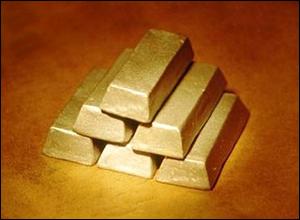By Pam Martens and Russ Martens: February 24, 2015
 The financial press is reporting this morning that the U.S. Justice Department is investigating at least 10 of the biggest U.S. and foreign banks for potentially rigging the gold market and other precious metals markets. That investigation comes while ongoing investigations continue into the potential rigging by big banks of the setting of interest-rate benchmarks and foreign currency.
The financial press is reporting this morning that the U.S. Justice Department is investigating at least 10 of the biggest U.S. and foreign banks for potentially rigging the gold market and other precious metals markets. That investigation comes while ongoing investigations continue into the potential rigging by big banks of the setting of interest-rate benchmarks and foreign currency.
Cartel activity in every facet of U.S. and London financial markets now seems to be the norm with regulators typically five to ten years too late in sniffing out the illegal conduct.
JPMorgan Chase was named by the Wall Street Journal as one of the banks under scrutiny in the precious metals probe. That could pose a particularly difficult situation for JPMorgan as it is under an effective two-year probation with the U.S. Justice Department for its role in the Bernard Madoff fraud. The probation stems from a deferred prosecution agreement, signed on January 6, 2014, requiring that for the next two years, JPMorgan had to bring to the attention of Federal prosecutors any knowledge of wrongdoing inside the bank, cooperate fully and in good faith, and agree to “commit no crimes under the federal laws of the United States subsequent to the execution of this agreement…” If JPMorgan did not live up to its end of the bargain, it could be prosecuted for new crimes as well as for the two felony counts related to the Madoff matter.
JPMorgan has already had to own up to a criminal investigation involving its foreign currency trading business. On November 24 of last year, when the bank filed its quarterly report with the SEC (known as the 10Q), it reported the following:
“DOJ is conducting a criminal investigation, and various regulatory and civil enforcement authorities, including U.S. banking regulators, the Commodity Futures Trading Commission (‘CFTC’), the U.K. Financial Conduct Authority (the ‘FCA’) and other foreign government authorities, are conducting civil investigations, regarding the Firm’s foreign exchange (‘FX’) trading business.
“These investigations are focused on the Firm’s spot FX trading activities as well as controls applicable to those activities. The Firm continues to cooperate with these investigations and is currently engaged in discussions with DOJ, and various regulatory and civil enforcement authorities, about resolving their respective investigations with respect to the Firm. There is no assurance that such discussions will result in settlements.”
In a front page article on February 10 of this year, the New York Times reported that federal prosecutors at the Justice Department who are conducting the foreign currency probes had “informed Barclays, JPMorgan Chase, the Royal Bank of Scotland and Citigroup that they must enter guilty pleas to settle the cases, according to lawyers briefed on the matter.”
The most interesting facet of this story that has not been linked by the news media to the current precious metals probe, are the findings about JPMorgan Chase that were made by the U.S. Senate’s Permanent Subcommittee on Investigations, which released an alarming 396-page report in November of last year on the physical commodity holdings of the largest Wall Street banks.
The report had this to say about JPMorgan:
“When the financial holding company’s physical commodities inventory of $6.6 billion is added to the bank’s metals inventory of approximately $8.1 billion – still excluding gold, silver, and all merchant banking commodity assets – and the bank’s copper, platinum, and palladium inventories of $2.7 billion are added in as well, the total market value of JPMorgan’s combined physical commodity inventories on September 28, 2012, was $17.4 billion. That $17.4 billion was about 11.75% of the financial holding company’s Tier 1 capital of $148 billion, which meant that it was more than twice the size allowed by the Federal Reserve’s 5% limit, were it to apply…
“In 2011 (the last complete year of figures provided to the Subcommittee), those inventories included, at various times, as much as 3.3 million metric tons of aluminum (an amount which is more than half of U.S. aluminum consumption that year), 200,000 metric tons of copper, 100,000 metric tons of lead, 6.4 million barrels of crude oil, 3.6 million barrels of heating oil, 900,000 barrels of gasoline, 3.4 million barrels of jet kerosene, and 51.9 billion cubic feet of natural gas. In addition, JPMorgan reported owning or controlling tolling agreements at 31 power plants…
“JPMorgan Chase Bank is the only national bank that, in recent years, has engaged in extensive physical metals trading and maintained a large physical metals inventory…
“JPMorgan’s physical metal activities resulted in its holding multi-billion-dollar inventories of various metals, including inventories that experienced significant volatility. For example, in 2010, JPMorgan’s inventory of nickel peaked at nearly $2.2 billion, only to fall nearly 85% soon after. Similarly, in 2011, JPMorgan’s platinum holdings peaked at nearly $1.5 billion, only to fall sharply after its peak. In the largest single base metals holding seen by the Subcommittee, in January 2012, JPMorgan held a nearly $7.5 billion inventory of aluminum, consisting of a whopping 3.5 million metric tons of aluminum, an amount exceeding over half of the entire North American annual consumption of aluminum that year.”
The report did not focus on JPMorgan’s involvement in the gold market and one has to now wonder if that was because there was already an ongoing criminal investigation at the U.S. Department of Justice.
The full report, together with exhibits, can be read here.

